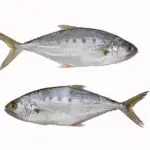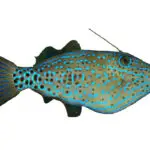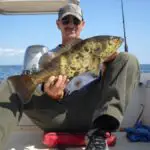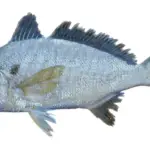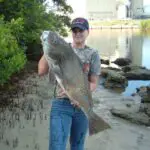Take one look at the teeth on a sheepshead, and you may be asking yourself ‘what the heck do those things eat?‘
Well, those human-like teeth are designed for a purpose. And understanding what they’re designed for, and what sheepshead eat will give you the information you need to catch more of these fun and under-rated fish.
Let’s dive in!
Table of Contents
- What Do Sheepshead Eat?
- What Is The Best Bait To Use For Sheepshead?
- Can you Chum for Sheepshead?
- Do Sheepshead Eat Squid?
- Do Sheepshead Eat Blue Crab?
- Do Sheepshead Eat At Night?
- Why Do Sheepshead Fish Have Human Teeth?
- Do Sheepshead Fish Bite Humans?
- Final Thoughts
- Related Posts
What Do Sheepshead Eat?
The diet of a sheepshead (Archosargus probatocephalus) varies considerably but centers around marine crustaceans and hard-shelled organisms. Barnacles, crabs, clams, shrimp, and marine detritus are among the sheepshead’s favorite foods.
Sheepshead are omnivores, meaning that they consume both plants and sea life. They are extremely diverse eaters, and they have the ability to adapt their diet and feeding habits based on the environment they live in (which can vary from brackish inshore mangroves to offshore reefs).
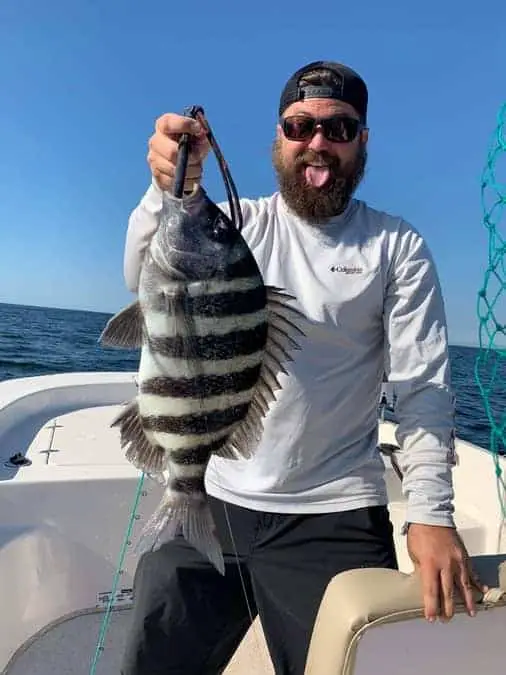
While sheepshead have been known to feed on over 100 different sea species and plants, there are certainly some “staple foods” that make up a large part of their diet. Let’s take a closer look at six of the sheepshead’s favorite snacks.
Fiddler Crabs
“Fiddler crab” is a blanket term for over 100 different species of small crabs, none of which exceed two inches. These small crabs are a staple food for sheepshead, and their hard exoskeleton is no match for the sheepshead’s rows of grinding teeth.
In most bait shops around the country that cater to sheepshead anglers, you can be they’ll have fiddler crabs for sale when they are in season.
Sand Fleas
Also known as mole crabs, sand crabs, and sand bugs, these small crustaceans are plentiful and readily available in many of the sheepshead’s natural habitats.
If you are lucky enough to live or fish near the beach, sandfleas are extremely easy to catch with a sandflea rake.
Oysters
The pointed, incisor-like front teeth of the sheepshead are shaped perfectly for breaking open oysters, as well as scraping the meat from the shell.
Although oyster bars can be challenging to fish around, they are a haven for marine fish such as sheepshead (as well as redfish!).
Clams
Full grown sheepshead are known to feast on clams of various sizes, using their hard teeth to pry or break them open before feeding.
Clams are usually available for purchase year-round…I’ve even used store-bought clams to catch sheepshead!
Barnacles
Barnacles are a living marine organsigm that loosely related to crabs and lobsters, and are another favorite of the sheepshead. Sheepshead tend to congregate around structures like dock pilings and bridges near shore, areas where barnacles are often present.
Shrimp
Sheepshead will also eat shrimp, and when they shrimp are running this can be one of the most effective baits.
What Is The Best Bait To Use For Sheepshead?
When fishing for sheepshead, live bait is always the best way to go. Fresh dead bait is a decent second option, and frozen should only be used if live bait and fresh dead aren’t available.
Artificial lures are rarely successful in catching sheepshead, and should only be used as a last resort. Here are four of the most popular baits used for catching sheepshead, as well as some best practices for using them.
Fiddler Crabs
Fiddler crabs are readily available for many fishermen, and one of the most popular baits used for catching sheepshead. Many anglers dislike the slight pinch that these small crabs pack, and there are some best practices to avoid getting pinched when putting them on the hook.
The simplest way to put a fiddler crab on a hook is by grabbing the center of their bodies from behind. Then feed the hook in through the bottom, and out through the top of the crab. Additionally, you can grab them by their claws to avoid getting pinched.
Sand Fleas
Sand fleas are easy to catch for beach anglers, and have long been known to catch sheepshead. The ticket with hooking sand fleas is to do it lightly through the top of their bodies. This way, it will be less likely to snag on underwater obstacles.
Live Shrimp
Live shrimp are another favorite bait of sheepshead fisherman, provided they are not too large. Only smaller shrimp should be used, no larger than 2-3 inches.
While there are many different ways to place a live shrimp on a hook, some of the best techniques for catching sheepshead are by inserting the hook either through the shrimp’s tail, or under its chin.
Can you Chum for Sheepshead?
An old fisherman’s trick for chumming the water for sheepshead is to scrape the barnacles off of docks, pier pilings, and seawalls. The scraping and falling barnacles will produce a sound that can scare fish off, but the smell will draw them back in.
In fact, you can usually spot a sheepshead angler because he will almost always have a small shovel or scraper in his boat!
It is always recommended to check your local rules regarding barnacle scraping, as well as checking the fishing area for any posted signs. This is a great way of chumming without spending any money, or needing to prepare and transport chum.
While there are also over-the-counter attractants that can be used to chum for sheepshead, many anglers have reported success using home made recipes. Chum buckets can be used, or chum can simply be thrown directly into the water.
One of the most popular recipes for homemade sheepshead chum is to take cooked rice and soak it in clam juice. Canned clams and crab can also be added, and some anglers have even reported success chumming the waters with a can of corn mixed with menhaden oil.
Do Sheepshead Eat Squid?
Squid is another food that sheepshead readily eat, that is often overlooked by anglers. Frozen squid can be purchased year-round from bait shops, and works really well tipped on a 1/2 ounce bottom sweep jighead.
Do Sheepshead Eat Blue Crab?
Most people think Sheepshead eat and prefer fiddler crabs, but blue crabs make up a large portion of their diet as well. The teeth of sheepshead are perfectly designed to crush up and pick apart large crustaceans, including big blue crabs.
Where I live along the Indian River, the blue crabs can tolerate freshwater just like sheepshead. This makes them an excellent bait choice in my area.
TIP: Go out at night and search along the tide lines for small blue crabs, shine your headlamp and look for the reflecting eyes and dip them up with a net!
Do Sheepshead Eat At Night?
One of the most effective times of day to target sheepshead is during the night when the fish are a little less line-shy and feed in the lights and shadows around structure.
Check out my full article on night fishing for sheepshead.
Why Do Sheepshead Fish Have Human Teeth?
Sheepshead have mouths full of large, strong teeth that are used for grinding shells and exoskeletons of shellfish and crustaceans they feed on. Their smiles look eerily like a human’s, with sharp incisor-like pointed teeth at the front of the mouth, and flat molars at the back.
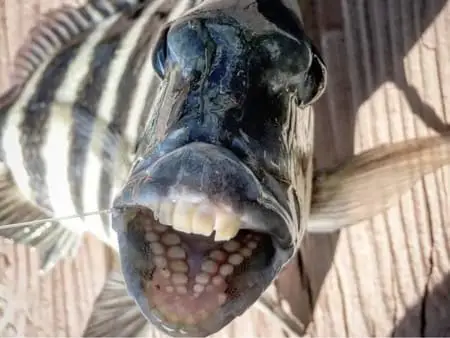
The sharper pointed teeth toward the front of their mouths are used to pry shellfish and barnacles loose, as well as pry them open. The flatter molars are used to crush and pulverize shells, as well as small bones and exoskeletons.
They have two rows of teeth on the bottom of their mouths, and three rows of teeth on top. These extra rows of teeth make for an efficient grinding platform in the mouth, and the sheepshead use this area to break down and grind up their hard-shelled prey.
Do Sheepshead Fish Bite Humans?
While the large, multi rowed teeth of the sheepshead may look intimidating to some, there is no risk of being by one while swimming. Like most other fish, sheepshead will be scared away by the presence of humans, and will not attack even if provoked.
The only way to get bit by a sheepshead is while handling one after catching it. Be extra careful when removing the hook from the mouth of a sheepshead, and never put your finger into its mouth.
The truth is, sheepshead are not a dangerous fish and do not pose any significant threat to angels.
However, they are delicious to eat!
Final Thoughts
I am a firm believer that if you can understand what a fish eats, you can be more successful when trying to catch it.
And when it comes to sheepshead, just take a look at the teeth. Those chompers are meant to chew up the crunchiest and hardest foods: barnacles, clams, crabs, sandfleas, shrimp etc.
If you can find the correct habitat (structure), and places where these baits naturally occur…the sheepshead wont be far behind.
Good luck!
You May Also Like: What Do Jack Crevalle Eat? (Know This, and Catch More!)

Growing up in Florida, I’ve been surrounded by saltwater my entire life…and I love sharing my passion with others.
To learn more about why I started Saltwater Mecca, visit the ABOUT page.
Thank you for reading this article. Browse around & have some fun!

